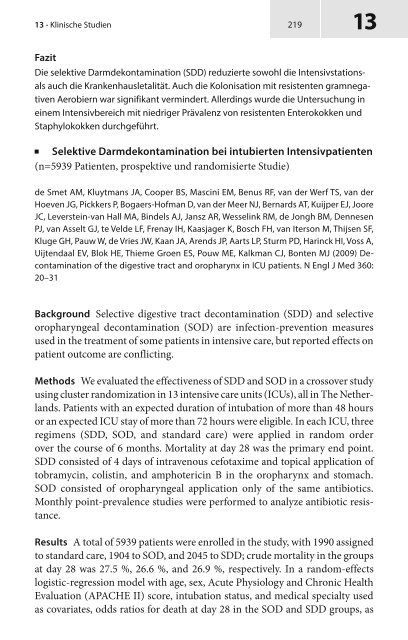Intensivmedizin Fragen und Antworten
Sie wollen auch ein ePaper? Erhöhen Sie die Reichweite Ihrer Titel.
YUMPU macht aus Druck-PDFs automatisch weboptimierte ePaper, die Google liebt.
13 · Klinische Studien<br />
219<br />
13<br />
Fazit<br />
Die selektive Darmdekontamination (SDD) reduzierte sowohl die Intensivstationsals<br />
auch die Krankenhausletalität. Auch die Kolonisation mit resistenten gramnegativen<br />
Aerobiern war signifikant vermindert. Allerdings wurde die Unter suchung in<br />
einem Intensivbereich mit niedriger Prävalenz von resistenten Enterokokken <strong>und</strong><br />
Staphylokokken durchgeführt.<br />
jSelektive Darmdekontamination bei intubierten Intensivpatienten<br />
(n=5939 Patienten, prospektive <strong>und</strong> randomisierte Studie)<br />
de Smet AM, Kluytmans JA, Cooper BS, Mascini EM, Benus RF, van der Werf TS, van der<br />
Hoeven JG, Pickkers P, Bogaers-Hofman D, van der Meer NJ, Bernards AT, Kuijper EJ, Joore<br />
JC, Leverstein-van Hall MA, Bindels AJ, Jansz AR, Wesselink RM, de Jongh BM, Dennesen<br />
PJ, van Asselt GJ, te Velde LF, Frenay IH, Kaasjager K, Bosch FH, van Iterson M, Thijsen SF,<br />
Kluge GH, Pauw W, de Vries JW, Kaan JA, Arends JP, Aarts LP, Sturm PD, Harinck HI, Voss A,<br />
Uijtendaal EV, Blok HE, Thieme Groen ES, Pouw ME, Kalkman CJ, Bonten MJ (2009) Decontamination<br />
of the digestive tract and oropharynx in ICU patients. N Engl J Med 360:<br />
20–31<br />
Backgro<strong>und</strong> Selective digestive tract decontamination (SDD) and selective<br />
oropharyngeal decontamination (SOD) are infection-prevention measures<br />
used in the treatment of some patients in intensive care, but reported effects on<br />
patient outcome are conflicting.<br />
Methods We evaluated the effectiveness of SDD and SOD in a crossover study<br />
using cluster randomization in 13 intensive care units (ICUs), all in The Netherlands.<br />
Patients with an expected duration of intubation of more than 48 hours<br />
or an expected ICU stay of more than 72 hours were eligible. In each ICU, three<br />
regimens (SDD, SOD, and standard care) were applied in random order<br />
over the course of 6 months. Mortality at day 28 was the primary end point.<br />
SDD consisted of 4 days of intravenous cefotaxime and topical application of<br />
tobramycin, colistin, and amphotericin B in the oropharynx and stomach.<br />
SOD consisted of oropharyngeal application only of the same antibiotics.<br />
Monthly point-prevalence studies were performed to analyze antibiotic resistance.<br />
Results A total of 5939 patients were enrolled in the study, with 1990 assigned<br />
to standard care, 1904 to SOD, and 2045 to SDD; crude mortality in the groups<br />
at day 28 was 27.5 %, 26.6 %, and 26.9 %, respectively. In a random-effects<br />
logistic-regression model with age, sex, Acute Physiology and Chronic Health<br />
Evaluation (APACHE II) score, intubation status, and medical specialty used<br />
as covariates, odds ratios for death at day 28 in the SOD and SDD groups, as


